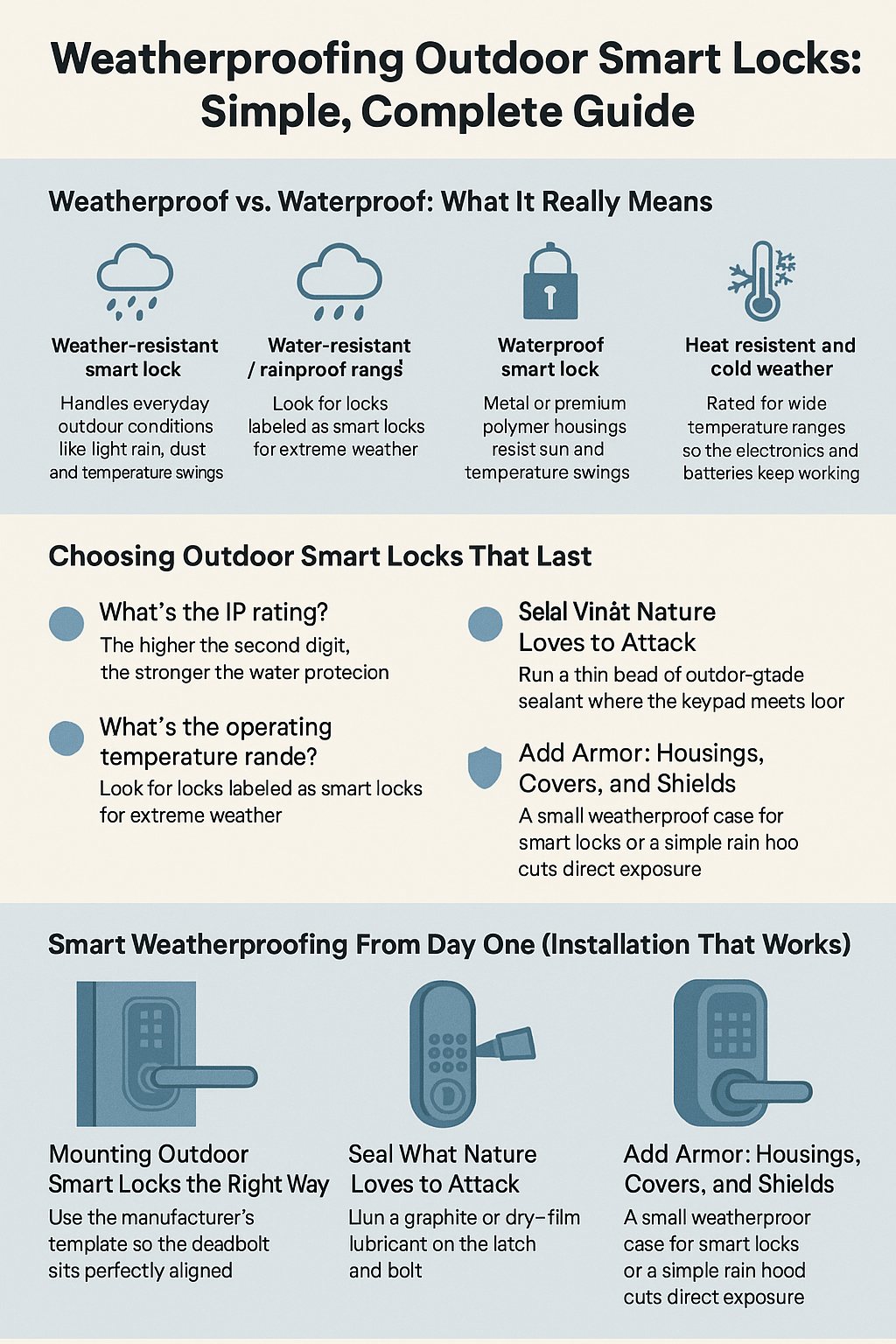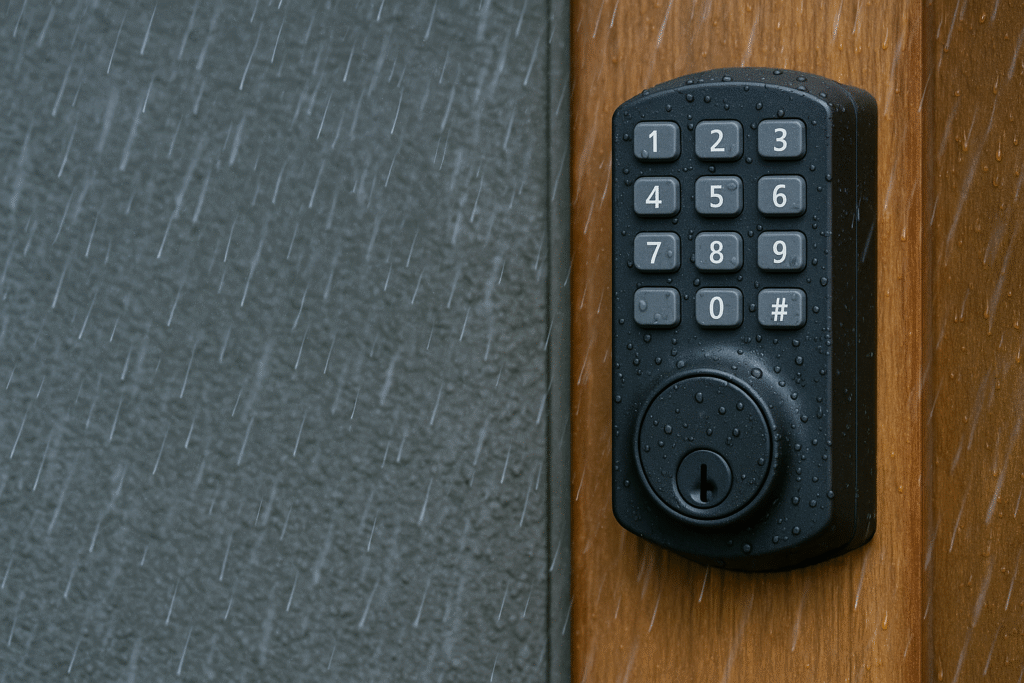Introduction
If you’ve ever rushed home during a storm and your front door lock decided to act up, you know the mix of panic and frustration that hits your stomach. Rain, snow, and heat don’t care how “smart” a device is. Outdoor smart locks live in the wild, which means they face wind, dust, sun, and surprise cold snaps. The good news? With a little know-how and regular care, your weatherproof smart locks can stay dependable, safe, and long-lasting—no drama, no soggy circuits.
This guide breaks everything down in simple, friendly language. You’ll learn what “weatherproof” really means, how to pick and protect outdoor smart locks, and how to install, maintain, and troubleshoot them so they keep doing their job through rainstorms, heat waves, and winter freezes. Let’s keep your door secure and your day stress-free.

Weatherproof vs. Waterproof: What It Really Means
Not all weather talk is the same. Here’s the plain-English version:
- Weather-resistant: Handles everyday outdoor conditions like light rain, dust, and temperature swings.
- Water-resistant / Rainproof smart locks: Built to stand up to rain, splashes, and drizzle without failing.
- Waterproof smart locks: Better sealed against water, but not meant to be submerged long-term.
- Snowproof smart locks: Designed to resist snow, ice buildup, and freeze-thaw cycles.
- Heat resistant smart locks and cold weather smart locks: Rated for wide temperature ranges so the electronics and batteries keep working.
IP Ratings: Your Quick Decoder
You’ll often see IP ratings for smart locks like IP65, IP67, or IP68. IP stands for “Ingress Protection,” and it tells you how well the device is sealed.
- IP65 smart locks: Dust-tight and protected against water jets—great for heavy rain and blowing dust.
- IP67 smart locks: Dust-tight and protected against temporary immersion—nice insurance in severe storms.
- IP68 smart locks: Dust-tight and protected against longer immersion—top-tier sealing for extreme conditions.
Tip: Match the IP rating to your climate. If you live where storms hit hard, consider IP67 or IP68. In milder, rainy areas, IP65 is often plenty.
Choosing Outdoor Smart Locks That Last
When shopping, think about smart lock durability first. Ask:
- What’s the IP rating? The higher the second digit, the stronger the water protection.
- What’s the operating temperature range? Look for locks labeled as smart locks for extreme weather.
- What’s the housing made of? Metal or premium polymer housings resist sun and temperature swings.
- How is the keypad sealed? Look for smart lock seals and gaskets and a membrane-type keypad to block moisture.
- Does the brand offer weatherproof models? Many do—August weatherproof locks, Schlage weatherproof locks, Yale weatherproof locks, and Kwikset weatherproof locks each have outdoor-ready options. Compare ratings and warranty language.
Pro move: Read the warranty. If the brand backs outdoor use and mentions water or weather resistance, that’s a good sign.
Smart Weatherproofing From Day One (Installation That Works)
A strong lock starts with a smart install. Here’s how to get outdoor smart lock installation right the first time.
1) Mounting Outdoor Smart Locks the Right Way
- Use the manufacturer’s template so the deadbolt sits perfectly aligned. Misalignment makes the motor work harder (and drains the battery).
- Avoid low spots that pool water. If your door frame holds water, add a sill or adjust the strike plate height.
- Keep direct sprinklers off the lock. Side-spray water can sneak under panels over time.
2) Seal What Nature Loves to Attack
A little sealing goes a long way:
- Sealing smart lock keypads: Run a thin bead of outdoor-grade, paintable sealant where the keypad meets the door if the manufacturer recommends it. Don’t block speaker holes or light sensors.
- Smart lock seals and gaskets: Make sure factory gaskets are seated flat—no twists or folds.
- Weatherproofing materials for smart locks: Use silicone gaskets, butyl tape for tiny gaps, and rust-resistant screws.
3) Add Armor: Housings, Covers, and Shields
- Smart lock housing protection: Choose models with metal faceplates or UV-stable housings.
- Smart lock covers and shields: A small weatherproof case for smart locks or a simple rain hood cuts direct exposure. Think baseball cap for your lock—shade helps!
- Face the keypad wisely: If possible, mount so wind-driven rain isn’t hitting the keypad square in the face.
Maintenance Made Easy (So Your Lock Stays Boringly Reliable)
Treat your lock like a car that lives outside: a little care, lots of reliability.
Outdoor Smart Lock Maintenance Checklist
Monthly (or after storms)
- Cleaning outdoor smart locks: Wipe with a damp cloth. Skip harsh cleaners; they can damage seals and coatings.
- Check for moisture: Peek under the battery cover and around seams. If you see fog or droplets, dry gently and improve the seal.
Every 3–6 months
- Lubricating smart lock mechanisms: Use a graphite or dry-film lubricant on the latch and bolt—not oil. Oil collects dust and grime.
- Battery care for outdoor smart locks: Use quality alkaline or lithium batteries that handle temperature swings. Replace early if you live in extreme heat or cold.
Seasonally
- Winter prep: For cold weather smart locks, add a tiny amount of dry lubricant to the keyway. Keep a physical key handy if ice is severe.
- Summer prep: For heat resistant smart locks, check the sun exposure. Add a small shade or shield if the lock bakes all afternoon.
Annually
- Regular inspections: Check the strike alignment, tighten mounting screws, replace worn gaskets, and refresh protective coatings for smart locks if the manufacturer recommends one.
Weatherproofing Materials That Actually Help
- Silicone gasket rings: Great around battery doors and keypad edges.
- Butyl tape: Sticky, moldable, and water-blocking; perfect for tiny seams the factory missed.
- Corrosion-resistant screws: Swap low-grade screws for stainless or coated screws to prevent rust stains.
- UV-resistant clear coat: If allowed by the manufacturer, a light, UV-safe clear coat on metal housings can slow sun fade.
- Neoprene covers: Soft covers that block rain without trapping moisture.
Always check your lock’s manual so you don’t void the warranty.
Connectivity When Weather Gets Weird
Outdoor conditions can mess with wireless signals and power use. Here’s how to keep things steady:
- Shorten the signal path: If your hub or router is far away, move it closer or add a range extender. Walls soaked by rain can weaken signals.
- Choose the right protocol: Zigbee, Z-Wave, Wi-Fi, or Thread—all can work outdoors, but range and battery use vary. If you’re far from the router, a low-power mesh (Zigbee/Thread) can be more reliable.
- Keep firmware updated: Updates often improve smart lock connectivity in extreme conditions and battery management.
Troubleshooting: When the Weather Wins (For a Minute)
Even the best outdoor smart locks can hiccup. Use this fast triage:
1) Smart Lock Malfunctions in Cold Weather
Symptoms: Slow motor, keypad lag, or temporary lockouts.
Fixes:
- Warm the lock with your hands or a warm (not hot) compress for a minute.
- Switch to lithium batteries—they handle cold better.
- Add a rain hood or cover to reduce ice buildup.
- Check strike alignment; cold can shrink materials and add friction.
2) Smart Lock Moisture Damage
Symptoms: Random beeps, foggy lens, unresponsive keypad.
Fixes:
- Remove batteries, open accessible panels, and air-dry in a warm, dry room.
- Replace any smart lock seals and gaskets that look flattened or torn.
- Apply butyl tape or a fresh gasket to suspect seams.
- If damage is severe, contact support before attempting deep repairs to preserve the warranty.
3) Smart Lock Connectivity in Extreme Conditions
Symptoms: Unlock delays, offline alerts during heavy storms or heat waves.
Fixes:
- Move the hub/router closer or add an extender.
- Check for metal boxes, mirrors, or brick walls blocking the signal path.
- Update firmware; reboot the lock and hub.
4) Battery Draining Too Fast
Causes: Misalignment, harsh temperatures, or sticky latch.
Fixes:
- Re-align the deadbolt so it slides smoothly by hand with the door open and closed.
- Use high-quality batteries rated for your climate.
- Lubricate the latch with dry-film lube.
Security Outside: Tough and Tamper-Aware
Weather isn’t the only concern. You also want smart lock security outdoors to be rock solid.
- Tamper resistance: Choose locks with reinforced housings, hidden mounting screws, and sensors that alert you if someone removes the cover.
- Outdoor lock encryption: Look for strong, modern encryption (like AES-level) and support for multi-factor app logins.
- Smart alerts: Set alerts for forced entry, repeated wrong codes, and offline status so you know what’s happening in real time.
- Physical backups: Keep a quality mechanical key and a well-installed deadbolt strike plate with long screws that reach the wall stud.
Mini Case Studies: Real-World Wins
Case 1: Mountain Cabin, Heavy Snow
Maya’s vacation cabin sits at the end of a windy ridge. Her first lock struggled each winter. She upgraded to a snowproof smart lock with an IP67 rating, added a small aluminum rain hood, and switched to lithium batteries. She also aligned the strike plate after the door swelled from moisture. Result: no mid-winter lockouts, and battery changes dropped from every 6 weeks to every 4–5 months.
Case 2: Coastal Home, Salt and Sun
Devin’s beach cottage roasted in afternoon sun and salt air. He chose a heat resistant smart lock with a UV-stable housing, used stainless screws, and applied a brand-approved protective clear coat. He also placed a small awning above the door. Two summers later, the finish still looks new, and the keypad stays responsive.
Case 3: Suburban Storm Belt, Sudden Downpours
Priya lives where storms hit hard and fast. Her first lock went flaky after sideways rain. She replaced it with a rainproof smart lock (IP65), added butyl tape to a tiny seam near the battery door, and installed a mesh hub closer to the entry. Now, even during intense rain, the lock stays online and responsive.
Best Practices for Outdoor Smart Lock Longevity
Consider this your “do these and relax” list:
- Pick the right IP rating for your climate.
- Install with care: proper alignment, factory gaskets seated, and seams sealed where appropriate.
- Add simple protections: covers, shields, and tiny awnings cut direct weather hits.
- Follow seasonal maintenance: cleaning, dry lubrication, and battery checks.
- Watch for early warning signs: sticky bolts, foggy panels, or rapid battery drain.
- Keep security tight: firmware updates, strong app security, and tamper alerts.
- Plan for storage: If a property sits empty for a season, replace batteries before leaving and schedule monthly remote checks.
Do these, and your lock will be like a well-trained guard—always ready, rarely fussy.

Conclusion
Your door is the line between “outside weather chaos” and “cozy home calm.” With the right weather resistance for smart locks, solid installation, and a little seasonal care, your outdoor lock can shrug off storms, snow, heat, and dust. Whether you prefer August, Schlage, Yale, or Kwikset, focus on IP ratings, smart sealing, and regular maintenance. That’s how you get everyday simplicity and long-term reliability—no nail-biting, just click-and-go.Ready to upgrade or tune up your lock? We can help you choose the right weatherproof smart lock, pick the best smart lock covers and shields, and set up a maintenance routine that fits your climate. Let’s make your entry smart, safe, and storm-proof.
